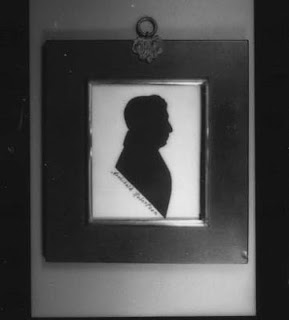It seems slightly sacrilegious to post on a non-Joycean topic right before Bloomsday, but we wanted to highlight some of the research our collections intern Anna Juliar has been doing. James Joyce did write a group of (now lost) short sketches called Silhouettes circa 1897, so, as with all things, there is some Joycean connection. Enjoy!
———————————————————————————
remembers having their silhouette cut by a person, or even produced by a
machine? I’ve never had a silhouette taken, but some of my friends remember
having them cut at fairs or at birthday parties as children. Here at the Rosenbach
we have quite a few silhouettes from the 19th century, some cut by
hand and some produced by a machine with a really fun-sounding name, the
“Physiognotrace.”
 |
|
Silhouette of Archibald
Robertson. c. 1800-1825. Rosenbach Museum & Library, 1954.0285 |
The
word silhouette has a surprisingly negative origin. During the 18th century,
the very unpopular finance minister Étienne de Silhouette served King Louis VX.
He lasted only eight months in his position, and soon afterwards anything cheap
or miserly was called “à la Silhouette.”
profile portrait, on the other hand, became very fashionable in Europe and
American during the late 18th to mid 19th centuries.
Spurred by the popular “science” of Physiognomy (the belief that a person’s
face contained evidence of moral and spiritual character), silhouettes were
cheap, quickly made, and easily mass-produced.
 |
|
Samuel Metford, silhouette of Noah Webster. 1842. Rosenbach Museum & Library,
1966.0011 |
silhouettists cut a piece of paper with a small pair of scissors while looking
at a sitter’s profile, and mounted the paper on a background. A number of
people still practice this craft today, and you can see a video of silhouette cutter Karl
Johnson here. This was
a demo for Martha Stewart’s show, and you can see how quickly he can capture
the little girl’s likeness, even as she is (very cutely) fidgeting on her
chair.
silhouettes were produced by devices that traced a person’s profile with a
metal point, and simultaneously reduced the image, which was then cut away. The
paper was often folded twice, resulting in the creation of four identical
silhouettes. Invented in France in 1789, the silhouette machine was developed
by many others and existed under a variety of names. Try saying these several
times fast: Ediograph, Limomachia, Pasigraph, Prosopographus, Profileograph,
Proportionometer.
in Philadelphia, the most famous machine resided in Charles Willson Peale’s
Museum. Operated for ten years by Peale’s former slave, Moses Williams, Peale’s
Physiognotrace was all the rage for the first decade of the 19th
century. In 1803 alone, Williams cut 8,880 profiles. It remained a popular
attraction until the rise of photography in the 1840s.
 |
|
Peale Museum Silhouette. 19th century. Rosenbach Museum & Library, 1954.0928
|
were given or exchanged to further cement social relationships, similarly to
the action of “friending” someone on Facebook today. Some silhouettes were
mounted and framed; others were simply slipped into the family bible or another
favorite book. Interestingly, the majority of silhouette albums produced in
Philadelphia were created by Quakers seeking to literally bind their community
together.
 |
|
Peale Museum Silhouette of
Margaret Vaux. 19th century. Rosenbach Museum & Library, 1954.0929 |
silhouette bears the Peale Museum stamp, and probably depicts Margaret Vaux of
the Quaker Vaux family
speaking, silhouettes were exchanged and traded among family members and
friends. Unlike painted portraits, the silhouette was an intimate art form that
was easily recognizable to acquaintances of the sitter, but was not specific
enough for a stranger to identify. Silhouettes were plain, “blank”
constructions of sitters which viewers could mentally fill in with all of the
subject’s details absent on the actual paper.
just as digital tools and apps like Instagram and Hipstamatic make digital
photographs appear
“vintage,” silhouettes are experiencing a small resurgence. A few weeks ago I
walked by a fine paper store on Walnut Street and saw this in the shop window:
 Anna Juliar is a Ph.D. student in Art History at the University of Delaware and a collections department intern at the Rosenbach Museum & Library
Anna Juliar is a Ph.D. student in Art History at the University of Delaware and a collections department intern at the Rosenbach Museum & Library

